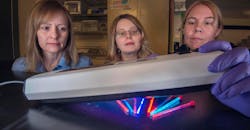Nanoparticles Let Doctors Keep Tabs on Cancer Cells
A team of researchers at Sandia National Laboratories has designed and synthesized metallic-organic framework materials (MOFs) that are safe, stable, and glow red or IR when inside the body. This makes them useful for tracking cancer growth and spread inside of patients, and could make them valuable for delivering therapeutic agents as well. MRIs, X-rays, and ultrasounds are well suited for diagnosing and tracking cancers and other diseases, but they are cannot treat diseases.
MOFs consist of molecules with metal “hubs” that attach to several carbon-based “rods.” Chemists can swap out the hubs and the rods to make nanosized “sponges” with many different properties. Historically, MOFs have been used for everything from capturing radioactive gases from spent nuclear fuel, to cleaning contaminated water, and even storing hydrogen gas safely.
The Sandia team tailored an MOF so that it glows red or near infrared for at least two days in cells. Near IR light has longer wavelengths than red light, so it is especially useful for imaging inside a body because it penetrates skin, tissue, and even bone without causing damage. It also lets doctors take clearer images of what’s going on inside the body because there’s less background autofluorescence at IR wavelengths. Current dyes or nanoparticles that glow in the near infrared don’t last as long or only glow weakly, making brighter, more stable materials invaluable.
To rationally design MOFs for bioimaging, the team started with lanthanide metals, a class of rare earth elements. One of them (europium) glows red, while two others (neodymium and ytterbium) fluoresce in the near infrared. Frequently, MOFs made with individual metal ions aren’t water-stable, a necessity when using them inside humans, but metal clusters are often water-stable.
So, the team set up conditions that would cause the lanthanides to form clusters. It also added carbon rods that create large pores. Potentially, these pores will hold drugs and allow both imaging and treatment. The team also made a family of similar MOFs with a range of emission colors from red to near IR, letting researchers “tune” the MOF color depending on what it might be needed for
Even at high doses, the MOF nanoparticles were similar to or less toxic than other particles being studied for bioimaging, which is a good sign for their future. They were also stable in water or biology-mimicking saltwater for a least a week.

